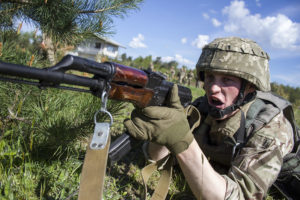
Ukraine’s military has broken through Russian lines in the Kharkiv region, gaining back nearly as much territory as the state of Rhode Island in just a few days. Jack Detsch reports for Foreign Policy:
The Ukrainian military has recaptured nearly 300 square miles of territory in a lightning dual counteroffensive in the south and the east of the country, a top Ukrainian general said Thursday, marking perhaps the most significant advance in the war in months.
After weeks of stalled fighting in and around the eastern Donbas region, Ukrainian troops began pushing Russian forces back from the country’s second-largest city of Kharkiv six days ago, threatening to cut vital supply lines for the Kremlin’s assault. And videos posted to social media showed that the snap offensive wasn’t just racking up Russian casualties but rows of prisoners.
The Ukrainian push on two fronts, striking both east toward Kharkiv and south toward Kherson, has put Russian forces on the back foot. Russia moved troops south when the big punch came in the east. “My understanding is that they are pushing everywhere,” said Tymofiy Mylovanov, an advisor to Ukrainian President Volodymyr Zelensky.
But the quick succession of military advances by Ukraine in the past several days, including into Balakliya and Shevchenkove—perhaps the largest of the war since Russian troops were pushed out of the Kyiv suburbs in late spring—has surprised some of the higher-ups in Kyiv, who expected the lightning offensive to move more slowly. On Wednesday, Colin Kahl, the U.S. Defense Department’s policy chief, referred to the Ukrainian moves as an “offensive,” the first time the Biden administration has used that word.
“They’ve done a lot of damage to the Russian forces” near Kherson, Kahl said at a defense conference near Washington. Ukraine’s armed forces said on Thursday that they had recaptured 20 settlements in the Kharkiv region from Russia. The push was made possible, in part, by long-range U.S. artillery.
“This is Ukraine cleverly spotting thin Russian lines with bad opportunities for redeployment, coupled with new, longer-range capabilities that can impact Russian forces,” said Oscar Jonsson, a researcher at the Swedish Defence University. The attacks also gave Ukrainian forces hope of retaking Izyum, captured by Russia in the early days of the April offensive in the Donbas region, and of cutting off the major supply junction at Kupyansk.
Yet just days after Russian President Vladimir Putin announced plans to mobilize 137,000 more troops by January—likely in a bid to stem troop losses in Ukraine—Ukrainian officials believe that the defenders have been able to take advantage by seizing on a moment to attack thinner Russian forces in Kharkiv just as they have shuttled in more reinforcements toward Kherson, which has been effectively ranged with U.S.- and European-provided Multiple Launch Rocket Systems.
“It seems like the Russians can’t hold the defense for the whole theater,” said Oleksiy Goncharenko, a Ukrainian lawmaker from Odesa. “They need to increase their presence somewhere. They need to take forces from somewhere.”
Goncharenko, a member of the opposition in Ukraine’s parliament, said Russia has also backfilled its ranks near Kharkiv with less experienced troops, such as those in Rosgvardia, Russia’s rough equivalent to the U.S. National Guard. But others said the Russian manpower shortages may be even more dire. “There are villages in eastern Ukraine where they have recruited everyone,” said Mylovanov, the advisor to Zelensky. “No one is left.”
If you’re willing to fight for Main Street America, click here to sign up for the Richardcyoung.com free weekly email.







